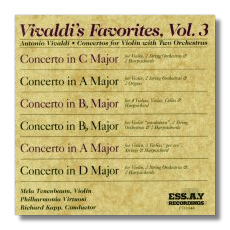
The Internet's Premier Classical Music Source
Related Links
- Vivaldi Reviews
- Latest Reviews
- More Reviews
-
By Composer
-
Collections
DVD & Blu-ray
Books
Concert Reviews
Articles/Interviews
Software
Audio
Search Amazon
Recommended Links
Site News
 CD Review
CD Review
Antonio Vivaldi

Vivaldi Favorites, Volume 2 -
Concertos for Violin with Two Orchestras
- Concerto in C Major for Violin, 2 String Orchestras & 2 Harpsichords, RV 581
- Concerto in A Major for Violin, 2 Orchestras & 2 Organs, RV 585
- Concerto in B Flat Major for 4 Violins, Violas, Cellos & Harpsichord, RV 553
- Concerto in B Flat Major for Violin scordatura, 2 String Orchestras & 2 Harpsichords, RV 583
- Concerto in A Major for Violin, 3 Violins "per eco," Strings & Harpsichord, RV 552
- Concerto in D Major for Violin, 2 String Orchestras & 2 Harpsichords, RV 582
Mela Tenenbaum, violin
Philharmonia Virtuosi/Richard Kapp
ESS.A.Y Recordings CD1046 1996 DDD 75:17
The third volume of the Philharmonia Virtuosi's collection of Vivaldi's favorites is framed by two of the composer's most spectacularly virtuosic concertos, written for the Feast of the Assumption. Whether these, or any of the others included in the program, are anybody's actual favorites may be questionable, but they certainly represent Vivaldi as an inexhaustible compounder of instrumental sonorities. The solo violin (occasionally scordatura), antiphonal string orchestras, organs, woodwinds, and harpsichords offer possibilities for numerous fresh textural combinations and recombinations that are unique even in Vivaldi's inventive oeuvre. The inclusion of all these concertos in a single program is therefore an especially striking testimonial to Vivaldi's productivity. In performances by violinist Mela Tenenbaum and the Philharmonia Virtuosi under the direction of Richard Kapp, this testimonial is as exuberant as it is eloquent. Tenenbaum is thoroughly individual in her approach. She sounds like neither the twangy, nasal period-instrument folk who are the usual champions of this repertoire (although Gidon Kremer recorded the Concerto RV 582 and Robert Gerle recorded the Concerto RV 583) nor the usual robustly singing modern-instrument folk who a generation ago had Vivaldi all to themselves. Her phrasing is brusque yet fiery, with a sort of Slavic passion that seems out of place in Vivaldi's quintessentially Venetian atmosphere. Nevertheless, her enthusiasm, like that of Philharmonia Virtuosi, goes a long way toward smoothing over any stylistic incongruities. It may be hard to imagine Vivaldi himself sounding anything like Tenenbaum, but her readings do full justice to his virtuosity, and they don't diminish his stature as do so many supposedly more authentic recreations./p>
William Zagorski's notes suggest that Vivaldi intended the three concertos RV 581-3, with their written-out cadenzas, for his own use. But they are not the only concertos for which he provided cadenzas. The astonishing one for the concerto in D Major, written for the Feast of the Tongue of St. Anthony of Padua, may, in fact, have been the occasion for Count von Uffenbach's remark about Vivaldi's playing close to the bridge with the fingers of his left hand.
The recording engineers have given Tenenbaum's brilliant playing an especially hard edge and have allowed an occasionally booming bass to disturb the balance. But the separation of the orchestral forces is adequate, enhancing the antiphonal interchange of incisive rhythmic motives.
While these performances may not be so authoritative as Tenenbaum's readings of the first six concertos of Locatelli's Art of the Violin, which appeared last year, the repertoire itself is perhaps more welcome. No one who admires the composer will be disappointed, and anyone who hasn't heard these concertos will be amazed by the richness of their musical ideas and stunned by the virtuosity of their solo parts. Highly recommended to all but purists.
Copyright © 1996, Robert Maxham


















